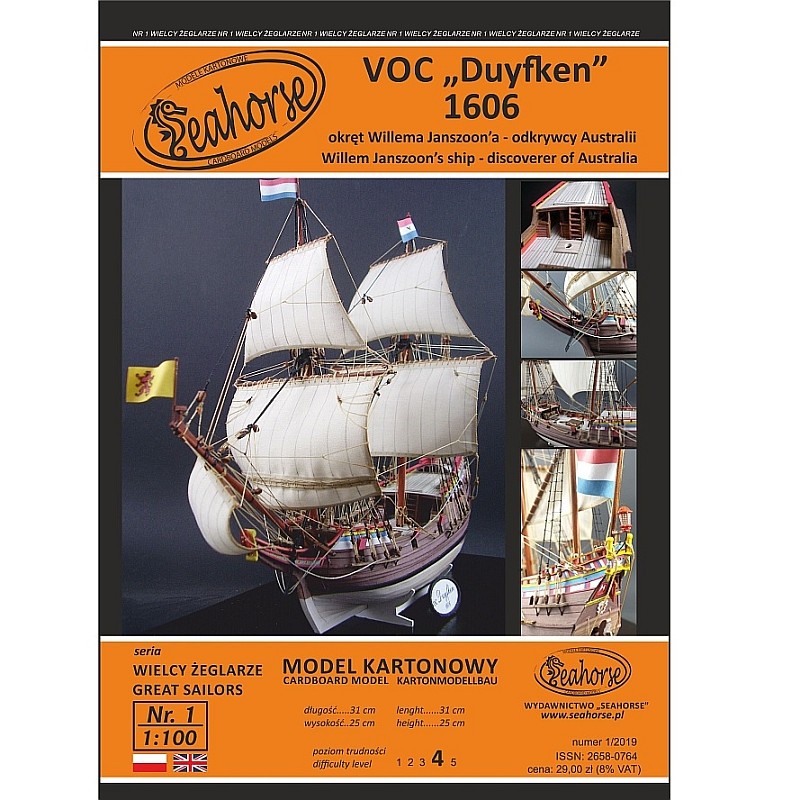- Out-of-Stock







VOC "Duyfken" 1606 - ship of Willem Janszoon - explorer of Australia.
Scale 1: 100
Author: T. Weremko
Difficulty level: 4/5
The model includes:
- history of the ship and biography of Willem Janszoon
- 8 x A4 pages with parts to cut out
- 25 assembly drawings
Model dimensions after gluing:
length: 31 cm
height: 25 cm
Willem Janszoon was born around 1570, but nothing is known about his early life.
He is first recorded in service to the Oude Compagnie, the predecessor of the East East Dutch Company (VOC), in 1598 as a mate aboard the Hollandia, a ship of the fleet of the second Dutch expedition to Indonesia under the command of Jacob Corneliszoon van Neck.
On May 5, 1601, he sailed again for the East Indies as master of the "Lam", one of three ships in Joris van Spilbergen's fleet.
Janszoon sailed from the Netherlands to the East Indies for the third time on December 18, 1603, as captain of "Duyfken", one of the twelve ships of the great fleet of Steven van der Hagen. It was then, when he was sent to the south-east to search for other outlets of trade, especially in New Guinea and further south from Java.
On November 18, 1605, Willem Janszoon, as commander of "Duyfken" set off from Bantam towards New Guinea,crossed the Arafura Sea into the Gulf of Carpentaria. There he anchored on the Pennefather River on the Cape York in Queensland near today's city of Weipa. There are many theories about the earlier discovery of Australia by sailors from China, France or Portugal, but Janszoon's expedition is the first documented and undisputed European landfall on the Australian continent.
Janszoon made about 320 km of shoreline map thinking it was the southern extension of New Guinea. During the expeditions, 10 people were killed and in June 1606 the ship returned to Bantam. Janszoon called the discovered land "Nieu Zeland", after the Dutch province of Zealand, but the name was not adopted and it was later used by Dutch cartographers for New Zealand.
In 1611 Janszoon returned to the Netherlands still believing that the lands he discovered were joint to New Guinea and this error was reproduced on Dutch maps for a long time.
In June 1618, Janszoon swam to Australia for the second time, most likely to Northwest Cape on the west coast near today's city of Exmouth.
Around 1619 he returned to the Netherlands, where he became a member of the Council of India and served as Vice-Admiral, and later Admiral in the Dutch fleet. In the same year, he received an award for taking over four ships of the British East India Company near Tiku in West Sumatra, which helped the Javanese defend Jakarta against the Dutch. He took part in negotiations in 1620 with the English, and later participated in the expedition to Manila against Chinese merchants trading with the Spaniards. In 1623-1627 he was the governor of Banda. After a diplomatic mission in India, he returned to the Netherlands in 1628. Nothing is known about the last years of Willem Janszoon's life. He probably died around 1630.
The "Duyfken" (Little Dove) was built in 1595 in the United Provinces (the Netherlands), as a fast, lightly armed small ship intended for transporting valuable cargoes. In the same year, she began together with three other ships (Amsterdam, Mauritius and Hollandia) under the command of Cornelis de Houtman the first trip to Indonesia, which aim was to break the domination of the Portuguese in this region. The expedition ended with the defeat.
In 1601 she again sailed with a fleet of five ships to the Far East. There, after reaching Bantam, they encountered a blockading fleet of Portuguese ships totalling 8 galleons and 22 galleys. They engaged this fleet in intermittent battle, driving them away on New Year's Day 1602.In April 1603, Duyfken returned to the Netherlands once again.
In December 1603, she sailed for another trip to India, as a ship of the newly established Dutch East India Company (VOC). Over the years, she participated in the battles between Dutch and Portuguese from Madagascar to New Guinea.
On November 18, 1605, Duyfken, led by Willem Janszoon, set off from Bantam towards New Guinea and after crossing the Arafura Sea, she entered the Gulf of Carpentaria. There she anchored on the Pennefather River on the York Peninsula near today's town of Weipa. There are many theories about the earlier discoveries of Australia by sailors from China, France or Portugal, but Janszoon's expedition is the first documented and indisputable discovery of this continent.
After another few years of service in 1608, the ship was brought inside the reef at Ternate for repairs, where she was hauled on her side. It seems that this caused further damage, which was considered too serious for any further repairs.
Thanks to Duyfken 1606 Replica Foundation established in 1993, the construction of the ship replica was started in 1997, which was completed on July 10, 1999. For more information, visit the Duyfken 1606 Replica Foundation website.
You might also like